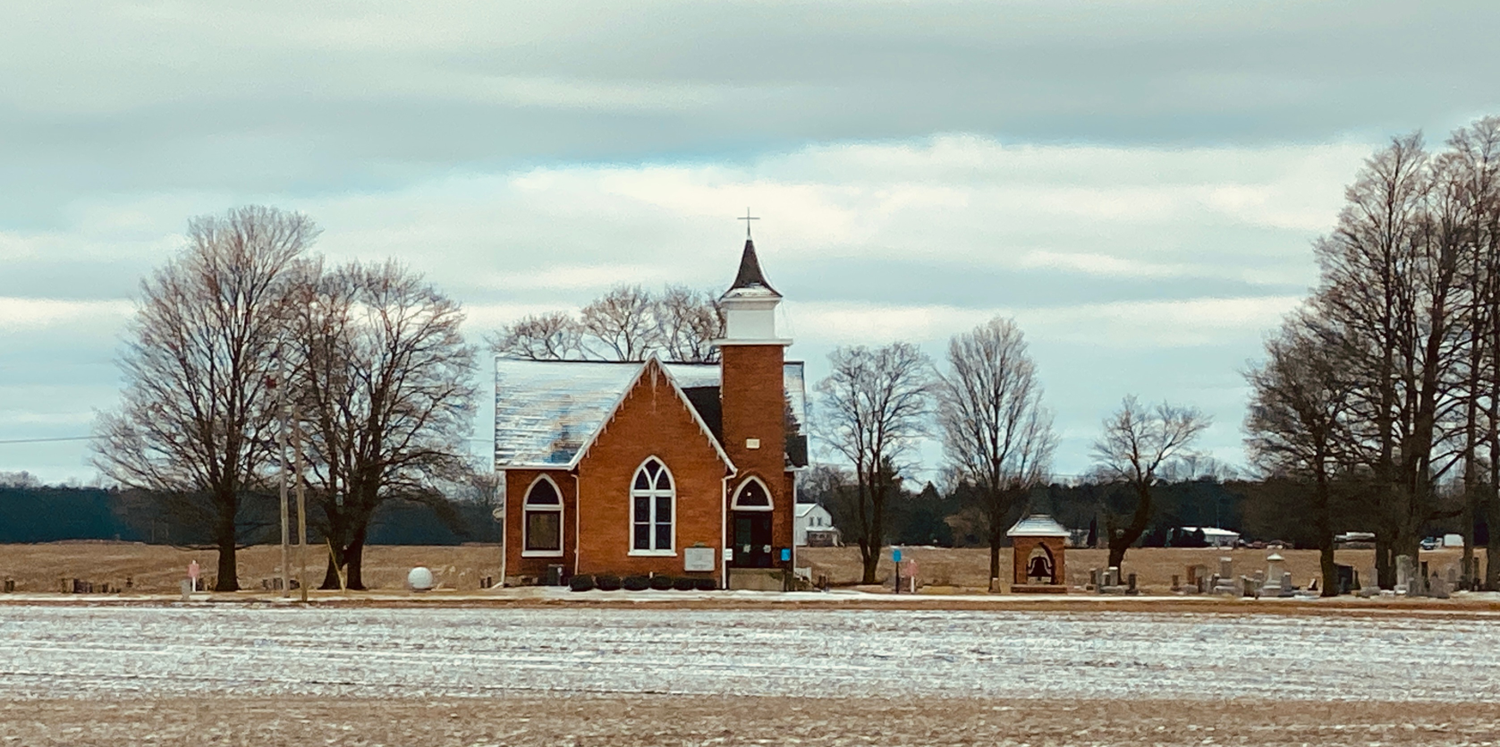The Indiana Toll Road is the portion of Interstate 90 that runs from Ohio to Illinois. For most of its distance it hugs the Michigan border. Earlier this week Becky and I were on the Toll Road headed to Chicago, and along the way Becky took the photo shown above – a little country church in Indiana about a half a mile south of the Michigan line.
Yes, it is a great photo and kudos to the photographer.
The scene and the photo taken from the Toll Road have gotten me thinking about the church.
I knew nothing about the church when we saw it on our trip. Since we got back home, a little Google Maps investigation and search engine work has provided a bit of information. The church is called Pretty Prairie Church, and its denominational website tells us 31 people attend worship at Pretty Prairie on a given Sunday. The satellite view on the map site shows the cemetery that surrounds the church building. Findagrave.com says there are 622 graves in the Pretty Prairie Cemetery; the first burial in the cemetery was nearly 200 years ago, the most recent occurred two weeks ago. The dead outnumber the living at Pretty Prairie 20 to 1. That’s the way it should be.
In 1645 Puritan preacher John Owen wrote two catechisms for his congregation at Fordham Parrish in Essex England. The Lesser Catechism was for children and the Greater Catechism was for adults. Chapter 16 of the Greater Catechism offers instruction on the nature of the church. Following the Protestant and Reformed traditions, the catechism teaches us that that the church exists now in two states, the church militant and the church triumphant:
Q.3 What is the church militant?
A. That portion of God’s elect which, in their generation, cleave unto Christ by faith, and fight against the world, flesh, and devil.
Q.4 What is the church triumphant?
A. That portion of God’s people who, having fought their fight and kept the faith, are now in heaven, resting from their labors.
John Calvin rightly reminds us of the distinction, too, between the church visible and the church invisible. Only God knows the members of the church invisible, those called by him and sealed in his love. We know the church visible among whom Calvin says, “there are very many ambitious, greedy, envious persons, evil speakers, and some of quite unclean life.”
It is not for us to determine among the 31 people in Sunday worship at Pretty Prairie Church (church militant) or of the 622 buried in the cemetery (church triumphant) who might be ambitious, greedy, envious, evil speakers or quite unclean in they way they live. We don’t know which might be “children by the grace of adoption and who are true members of Christ by sanctification of the Holy Spirit.”
The communion of the saints at Pretty Prairie includes those who now cleave unto Christ and those who have fought their fight and kept the faith. The visible church at Pretty Prairie undoubtedly includes some who are quite unclean in the way they live.
We don’t know if Pretty Prairie Church, the building and the 31 folks who show up for Sunday worship, will still be open five years from now. The chances are good that it may not. More than at any time in our living memory, churches are closing. Among the churches I know through my denominational work, many like Pretty Prairie are probably just a few years away from closing. Demographics, geography, and cultural trends are not in their favor. Churches, individual congregations, close by circumstance, failure of leadership, and fear of faithfulness. Maybe not Pretty Prairie, but many churches like her will be gone before the decade is out.
Churches close. Congregations die. Old buildings are abandoned and cemeteries are overrun by thorns and thistles.
The last question of Chapter 16 of John Owen’s Greater Catechism offered hope to the people of Fordham Parrish:
Q. 7 Can this church be wholly overthrown on the earth?
A. No; unless the decree of God may be changed, and the promise of Christ fail.
The odds of Christ’s promises failing are nil.

